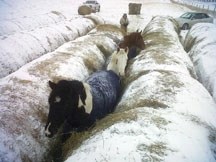When last week’s frigid temperatures sent people running for shelter, it wasn’t much different for the animals on the fields across the foothills.
The -30 C weather forced James Kunz’s 10 horses to go looking for shelter. But, instead of one of the shelters set up in a pasture west of Okotoks, they went to one of their favourite spots a large grouping of round hay bails stored in a corner of the field.
His horses wear blankets and have access to shelter, but he said they often choose to go to the bails instead.
“They figured out there is enough space between the bails that they could stand between them to stay warm,” said Kunz. “That seemed to work for the first few days.”
This time they went a little too far and they got stuck. It took a tractor to move the bails out of the way to free the horses.
“They didn’t seem to have any discomfort, but we were worried about them being in there all night,” he said.
When temperatures plummet, veterinarians say people need to take steps to help keep animals warm.
Okotoks veterinarian Rick Dalrymple said the most important things with horses and livestock is to give them a shelter to get out of the wind.
“That’s number one, keep them out of the wind,” he said.
Secondly, Dalrymple said animals need more food when the mercury drops to help keep their metabolism and core temperatures up.
“They basically need to fuel the fire and the more feed they have the better they can keep their internal temperature as it should be,” he said.
When it comes to household pets, frostbite is a big concern.
Dalrymple said dogs are highly susceptible to frostbite on their paws and the tips of their ears.
“You can’t keep them out for very long at all where frostbite may be an issue,” he said.
Dalrymple said people could use boots or coats so their pets can stay outside for longer. Yet, he said not to overdo it with coats because animals still need to be able to regulate their temperatures.
According to Dalrymple, people have to be aware about the risk of animals sweating after being brought indoors and then being sent outside. For this reason, he said people shouldn’t put blankets on their horses when it’s not cold enough.
Dalrymple also said not to leave animals in a vehicle in cold weather.
“It seems to be common sense, but do not keep your dogs in vehicles when it’s cold because once that heat is gone the car will act like a refrigerator,” he said.
This week’s rising temperatures may remove the risk from cold weather, but he said they bring a new risk. As snow and ice melts, Dalrymple said people need to make sure they don’t ingest salts and other chemicals used to remove ice from the roads.
“They are quite toxic to our pets and when things start melting we have to really make sure our pets aren’t ingesting or licking the road salts, sidewalk salts,” he said.
These recommendations are all taken to heart by foothills Rancher Grant Hirsche.
With large cattle herds, he said it’s not possible to bring all the animals inside at night.
“If you have a herd of 10 or 20 and you have a big barn, yeah, you can open the door and run them in every night and some people do that,” said Hirsche. “But when you have a large herd, you can’t do it.”
He said the main thing to keeping animals warm in the fields is to make sure they have extra bedding and shelter to get out of the wind. Hirsche also has special sheds just for calves.
During calving sesson, he said it’s critically important to make sure animals born at this time of year are out of the cold right after they’re born.
“That’s the hard part, they won’t last 15 minutes when it’s 30 below,” said Hirsche.
He said they need to be kept inside a warm building for at least 24 hours until they dry off, when it’s okay to go outside.




